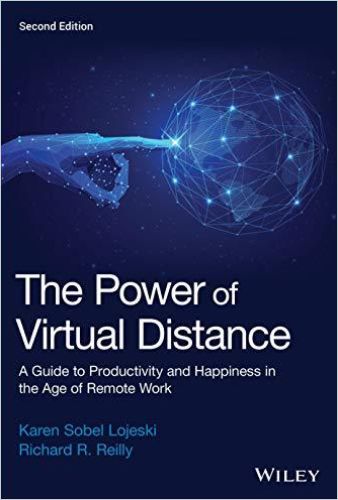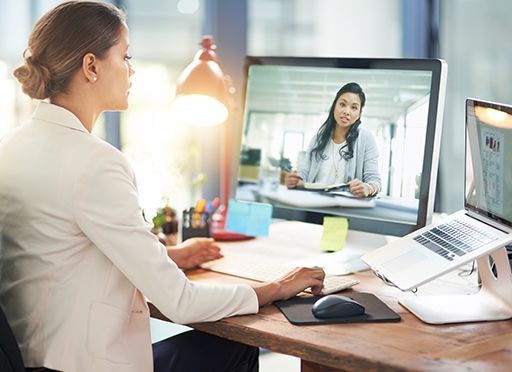“Technology Is Not the Real Problem Here.”

Karen, in a nutshell, what is “Virtual Distance”?
Dr. Karen Sobel Lojeski: Virtual Distance describes a felt sense of distance from others, especially when our communications are largely mediated by smart devices. On one hand, it describes a set of metrics, a deep set of analytics that express what we are trying to showcase. On the other hand, the term serves as a door opener. It puts into language something people experience but have a hard time explaining. When Virtual Distance is high, we don’t get any feeling about others because there is a lack of context. Without it, we end up misinterpreting what people mean. This then changes the way we behave, make decisions and frame our understanding of ourselves in relation to other people on both a social and emotional level. Ultimately, Virtual Distance captures the unintended consequences of relationships built on a fragile and thin layer of technology alone. Importantly, Virtual Distance represents the things that get lost about us as interconnected human beings through our relationships with one another – aspects we will need to reconstitute in order to get the best out of technological interactions in light of our well-being.
You published the first edition of The Power of Virtual Distance in 2008 and updated it in 2020. In the past 12 years, new collaboration tools and software have become available to facilitate interactions between physically distant team members. Have some of these technological improvements helped decrease Virtual Distance?
If you think of Virtual Distance as the subtotal of these unintended consequences, you will see: Technology is not the real problem here. Virtual Distance stems mostly from a misunderstanding of what we are trying to say to each other, especially when we are divorced from the context that makes us feel more closely connected to the other person. And it’s also important to remember that you can have low Virtual Distance between people who never meet and high Virtual Distance between people in the same room. So we shouldn’t really focus on the technology beyond remembering to mix up communication modes like email, phone or video according to Virtual Distance guidelines.

You are saying that the problem is ultimately not about technology – it’s about people.
Early in the pandemic, I was asked to write a white paper on which technologies would be best to reduce Virtual Distance. And I still get that question today, even after explaining that Virtual Distance is a human-based phenomenon. What we need to do instead is to awaken to Virtual Distance and the possibility of it rising in a way that interferes with building close relationships – and then find better ways to use the technologies we have in order to reduce Virtual Distance.
You can have low Virtual Distance between people who never meet and high Virtual Distance between people in the same room.
Karen Sobel Lojeski
We now have so many interactive tools at our disposal to communicate remotely. Depending on whether Virtual Distance is high or low, how do I go about picking the right technology to communicate?
If you have high Virtual Distance, I’d recommend using the simplest technology that you can find: Pick up the phone, or do a simple one-to-one video call. You want to cut through the noise of the technology to see each other more clearly. When Virtual Distance is low and the fundamental relationships between people have been established and then get stronger, it’s possible to use more nuanced and sophisticated technologies to bring out more context in people.
In the spring of 2020, when millions of knowledge workers around the world suddenly found themselves working from their home offices, there was a lot of enthusiasm about remote work. You were very hesitant about jumping into the conversation and handing out advice on how to work remotely. Why?
Advice and guidance around Virtual Distance is helpful to people, but during lockdown, people were dealing with much more than just increased Virtual Distance. People were operating with trauma brain, extreme isolation and cognitive dissonance piled on top of what I would call “everyday” Virtual Distance as it was before the lockdowns. The results of employee surveys conducted early in the pandemic were misleading. A survey conducted by one of my clients, for example, found that employee engagement went way up after the lockdown. But I don’t think the result was a reflection of how excited people felt about working remotely. I think the survey was actually measuring the extent to which people felt confident about the way the company was handling the situation.
So people saw the remote work arrangements as a temporary thing?
It’s hard to say but in the beginning, I don’t think anyone could have imagined that remote work forced upon society as a way to stay safe and healthy was going to be “permanent.” So I don’t think the surveys taken at that time were just an expression of being 100% happy and comfortable at home.
As people are coming out of that fight-or-flight mode, they are now waking back up to their human nature and their need for social contact.
Karen Sobel Lojeski
We are not machines, right? So I think we mixed up a lot of different things when surveying people in the beginning and even today. It’s not surprising to me now that many people are saying, “I want to go back to the office, at least some of the time.” Most people work because they like socializing and broadening their horizons – and you can’t do that by yourself.
The pandemic has made us all more aware of the negative consequences associated with Virtual Distance. Do you think companies are drawing the right lessons from the experience?
I hope so. I am currently working with a $35 billion European organization that is very concerned about not losing the positive momentum set in motion during the pandemic. During most of 2020, employees were feeling protected and cared for by the company. Although the company wants to find ways back to what we knew as normal, leadership also want to continue to provide people with that feeling of being cared for.
What advice did you give to the organization?
I asked the company to map out, month by month, what was happening at the country and global level, and what the company did for its employees in response to each event. What this exercise brought out very clearly was that the company was making great efforts at improving communication with its employees and giving them access to extra resources, such as crisis hotlines. In addition, I suggested they detail how they helped their customers get through using the same technique. At the community level, the company got very creative at helping to keep essential services running during the height of the pandemic. So, when they looked at the whole picture they could see this amazing story. I advised leadership to capture these very rich details and build them into the “zeitgeist” of the corporate culture.
So creating a company narrative around this shared experience was a way for the company to reduce Virtual Distance?
Exactly. It was important not to lose the details of the actions the company took, because keeping these stories alive is a powerful way to shrink Virtual Distance during this crisis. You can then pick out pieces of that story that are exemplars of how they reduced Virtual Distance, and repeat and replicate them over time.
Has the COVID-19 crisis created a window of opportunity for companies to make the workplace more humane or human-centric?
I hope so. I believe that there is a window open at this moment that could usher in a paradigm shift in the way companies manage their employees – provided they are willing to let go of old management models that are based on assumptions that have largely ceased to exist. For almost 20 years, companies have gone back and forth between letting employees work remotely and pulling them back into the office – which employees did not appreciate. There are ways to manage employees without keeping a tight grip on them all the time.
So could the COVID-19 crisis serve as a catalyst for what you describe in your book as “Soul-Based Leadership”?
We have known for a long time that when you pay attention to people, regardless of the work conditions, their productivity and their experience of meaningfulness, respect and dignity goes up.
Employees work better if they know that leadership cares for them on a human level – that they are seen and heard.
Karen Sobel Lojeski
For many years, I have been looking for a way to frame leadership as a humanistic approach as opposed to a process-oriented task. Because what you are really doing as a leader is trying to support people, to encourage them to use all of who they are and to take direction in a way that is mutually beneficial for them and the company. Of course, this is hard to do in a world where we are digitally removed from one another most of the time and can’t really experience each other fully. Soul-Based Leadership is something that’s based on our “aliveness” as human beings. If leaders can keep this in mind, we can move from here into a more “enlightened” business climate because we are focusing on people’s vitality as opposed to just being cogs in the wheel.
You argue that Virtual Distance has little to do with being physically apart. What can leaders do to reduce Virtual Distance as employees return to their offices?
A big study published by Harvard Business Review showed that face-to-face interaction went down 75% when people work together in an open office. So regardless of general return to work strategies, leaders should ask themselves “How can I encourage people to develop trust for one another?” And that means reducing Virtual Distance, regardless of how many plants or windows there are in any given space. What is going to get people to collaborate is a trusting work environment, no matter where people are or what that space looks like. And that doesn’t happen spontaneously when machines often mediate our interactions. Big campuses with pool tables and meditation rooms can be very helpful as long as leaders don’t count on them to do the work they themselves need to do. The word “authentic” has been overused in so many ways. However, if we can lead with our heart first, we’ll be able to make meaningful work “mean” something true in a sustainable and more collaborative way.
About the Author
Dr. Karen Sobel Lojeski leads Virtual Distance International, a research and consulting firm that helps organizations manage Virtual Distance.
Virtual Distance and Soul-Based Leadership are registered trademarks of Virtual Distance International LLC.







